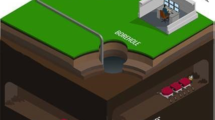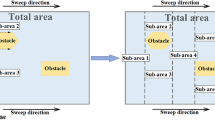Abstract
With the proposal of intelligent mines, unmanned mining has become a research hotspot in recent years. In the field of autonomous excavation, environmental perception and excavation trajectory planning are two key issues because they have considerable influences on operation performance. In this study, an unmanned electric shovel (UES) is developed, and key robotization processes consisting of environment modeling and optimal excavation trajectory planning are presented. Initially, the point cloud of the material surface is collected and reconstructed by polynomial response surface (PRS) method. Then, by establishing the dynamical model of the UES, a point to point (PTP) excavation trajectory planning method is developed to improve both the mining efficiency and fill factor and to reduce the energy consumption. Based on optimal trajectory command, the UES performs autonomous excavation. The experimental results show that the proposed surface reconstruction method can accurately represent the material surface. On the basis of reconstructed surface, the PTP trajectory planning method rapidly obtains a reasonable mining trajectory with high fill factor and mining efficiency. Compared with the common excavation trajectory planning approaches, the proposed method tends to be more capable in terms of mining time and energy consumption, ensuring high-performance excavation of the UES in practical mining environment.

Similar content being viewed by others
References
Wei B C, Gao F. A method to calculate working capacity space of multi-DOF manipulator and the application in excavating mechanism. Frontiers of Mechanical Engineering, 2012, 7(2): 109–119
Wei B, Gao F, Chen J, He J, Zhao X. A method for selecting driving system parameters of a new electric shovel’s excavating mechanism with three-DOF. Proceedings of the Institution of Mechanical Engineers, Part C: Journal of Mechanical Engineering Science, 2011, 225(11): 2661–2672
Wu J Q, Wang G Q, Bi Q S, Hall R. Digging force and power consumption during robotic excavation of cable shovel: experimental study and DEM simulation. International Journal of Mining, Reclamation and Environment, 2021, 35(1): 12–33
Awuah-Offei K, Frimpong S. Numerical simulation of cable shovel resistive forces in oil sands excavation. International Journal of Mining, Reclamation and Environment, 2006, 20(3): 223–238
Stavropoulou M, Xiroudakis G, Exadaktylos G. Analytical model for estimation of digging forces and specific energy of cable shovel. Coupled Systems Mechanics, 2013, 2(1): 23–51
Rasuli A, Tafazoli S, Dunford W G. Dynamic modeling, parameter identification, and payload estimation of mining cable shovels. In: Proceedings of 2014 IEEE Industry Application Society Annual Meeting. Vancouver: IEEE, 2014, 1–9
Shekhar R C, Maciejowski J M. Surface excavation with model predictive control. In: Proceedings of the 49th IEEE Conference on Decision and Control (CDC). Atlanta: IEEE, 2010, 5239–5244
Awuah-Offei K, Frimpong S. Efficient cable shovel excavation in surface mines. Geotechnical and Geological Engineering, 2011, 29(1): 19–26
Patnayak S, Tannant D D. Performance monitoring of electric cable shovels. International Journal of Surface Mining, Reclamation and Environment, 2005, 19(4): 276–294
Frimpong S, Li Y. Stress loading of the cable shovel boom under in-situ digging conditions. Engineering Failure Analysis, 2007, 14(4): 702–715
Li Y, Frimpong S. Hybrid virtual prototype for analyzing cable shovel component stress. The International Journal of Advanced Manufacturing Technology, 2008, 37(5–6): 423–430
Frimpong S, Hu Y F. Intelligent cable shovel excavation modeling and simulation. International Journal of Geomechanics, 2008, 8(1): 2–10
Song X G, Zhang T C, Yuan Y L, Wang X B, Sun W. Multidisciplinary co-design optimization of the structure and control systems for large cable shovel considering crossdisciplinary interaction. Proceedings of the Institution of Mechanical Engineers, Part C: Journal of Mechanical Engineering Science, 2020, 234(22): 4353–4365
Osa T, Aizawa M. Deep reinforcement learning with adversarial training for automated excavation using depth images. IEEE Access: Practical Innovations, Open Solutions, 2022, 10: 4523–4535
Yoshida H, Yoshimoto T, Umino D, Mori N. Practical full automation of excavation and loading for hydraulic excavators in indoor environments. In: Proceedings of 2021 IEEE the 17th International Conference on Automation Science and Engineering (CASE). Lyon: IEEE, 2021, 2153–2160
Zhang L J, Zhao J X, Long P X, Wang L Y, Qian L F, Lu F X, Song X B, Manocha D. An autonomous excavator system for material loading tasks. Science Robotics, 2021, 6(55): eabc3164
Phillips T G, Green M E, McAree P R. Is it what I think it is? Is it where I think it is? Using point-clouds for diagnostic testing of a digging assembly’s form and pose for an autonomous mining shovel. Journal of Field Robotics, 2016, 33(7): 1013–1033
Zhang T C, Fu T, Song X G, Qu F Z. Multi-objective excavation trajectory optimization for unmanned electric shovels based on pseudospectral method. Automation in Construction, 2022, 136: 104176
Phillips T, Hahn M, McAree R. An evaluation of ranging sensor performance for mining automation applications. In: Proceedings of 2013 IEEE/ASME International Conference on Advanced Intelligent Mechatronics. Wollongong: IEEE, 2013, 1284–1289
Phillips T G, Guenther N, McAree P R. When the dust settles: the four behaviors of LiDAR in the presence of fine airborne particulates. Journal of Field Robotics, 2017, 34(5): 985–1009
Green M E, Ridley A N, McAree P R. Pose verification for autonomous equipment interaction in surface mining. In: Proceedings of 2013 IEEE/ASME International Conference on Advanced Intelligent Mechatronics. Wollongong: IEEE, 2013, 1199–1204
D’Adamo T A, Phillips T G, McAree P R. Registration of threedimensional scanning LiDAR sensors: an evaluation of modelbased and model-free methods. Journal of Field Robotics, 2018, 35(7): 1182–1200
Dunbabin M, Corke P. Autonomous excavation using a rope shovel. Journal of Field Robotics, 2006, 23(6–7): 379–394
Awuah-Offei K, Frimpong S. Cable shovel digging optimization for energy efficiency. Mechanism and Machine Theory, 2007, 42(8): 995–1006
Bi Q S, Wang G Q, Wang Y P, Yao Z W, Hall R. Digging trajectory optimization for cable shovel robotic excavation based on a multi-objective genetic algorithm. Energies, 2020, 13(12): 3118
Jud D, Leemann P, Kerscher S, Hutter M. Autonomous free-form trenching using a walking excavator. IEEE Robotics and Automation Letters, 2019, 4(4): 3208–3215
Son B, Kim C U, Kim C, Lee D. Expert-emulating excavation trajectory planning for autonomous robotic industrial excavator. In: Proceedings of 2020 IEEE/RSJ International Conference on Intelligent Robots and Systems (IROS). Las Vegas: IEEE, 2020, 2656–2662
Lee D, Jang I, Byun J, Seo H, Kim H J. Real-time motion planning of a hydraulic excavator using trajectory optimization and model predictive control. In: Proceedings of 2021 IEEE/RSJ International Conference on Intelligent Robots and Systems (IROS). Prague: IEEE, 2021, 2135–2142
Wang X B, Sun W, Li E, Song X G. Energy-minimum optimization of the intelligent excavating process for large cable shovel through trajectory planning. Structural and Multidisciplinary Optimization, 2018, 58(5): 2219–2237
Wang X B, Song X G, Sun W. Surrogate based trajectory planning method for an unmanned electric shovel. Mechanism and Machine Theory, 2021, 158: 104230
Nurunnabi A, West G, Belton D. Robust locally weighted regression techniques for ground surface points filtering in mobile laser scanning three dimensional point cloud data. IEEE Transactions on Geoscience and Remote Sensing, 2016, 54(4): 2181–2193
Holz D, Ichim A E, Tombari F, Rusu R B, Behnke S. Registration with the point cloud library: a modular framework for aligning in 3-D. IEEE Robotics & Automation Magazine, 2015, 22(4): 110–124
Durovsky F. Point cloud based bin picking: object recognition and pose estimation using region growing segmentation algorithm. Applied Mechanics and Materials, 2015, 791: 189–194
Jain K, Pannu H S. Autonomic point cloud-based surface reconstruction using SVR. The Imaging Science Journal, 2018, 66(1): 59–67
Slabanja J, Meden B, Peer P, Jaklič A, Solina F. Segmentation and reconstruction of 3D models from a point cloud with deep neural networks. In: Proceedings of 2018 International Conference on Information and Communication Technology Convergence (ICTC). Jeju: IEEE, 2018, 118–123
Pan R J, Skala V. A two-level approach to implicit surface modeling with compactly supported radial basis functions. Engineering with Computers, 2011, 27(3): 299–307
Zhao S, Lu T F, Koch B, Hurdsman A. Dynamic modelling of 3D stockpile for life-cycle management through sparse range point clouds. International Journal of Mineral Processing, 2013, 125: 61–77
Nazemizadeh M, Rahimi H N, Amini Khoiy K. Trajectory planning of mobile robots using indirect solution of optimal control method in generalized point-to-point task. Frontiers of Mechanical Engineering, 2012, 7(1): 23–28
Powell M J D. A direct search optimization method that models the objective and constraint functions by linear interpolation. In: Gomez S, Hennart J P, eds. Advances in Optimization and Numerical Analysis. Mathematics and Its Applications, vol 275. Dordrecht: Springer, 1994
Panda B, Garg A, Jian Z, Heidarzadeh A, Gao L. Characterization of the tensile properties of friction stir welded aluminum alloy joints based on axial force, traverse speed, and rotational speed. Frontiers of Mechanical Engineering, 2016, 11(3): 289–298
Rossi C, Savino S. Robot trajectory planning by assigning positions and tangential velocities. Robotics and Computer-Integrated Manufacturing, 2013, 29(1): 139–156
Acknowledgements
This work was supported by the National Natural Science Foundation of China (Grant No. 52075068) and the Science and Technology Major Project of Shanxi Province, China (Grant No. 20191101014).
Author information
Authors and Affiliations
Corresponding author
Rights and permissions
About this article
Cite this article
Zhang, T., Fu, T., Cui, Y. et al. Toward autonomous mining: design and development of an unmanned electric shovel via point cloud-based optimal trajectory planning. Front. Mech. Eng. 17, 30 (2022). https://doi.org/10.1007/s11465-022-0686-2
Received:
Accepted:
Published:
DOI: https://doi.org/10.1007/s11465-022-0686-2




